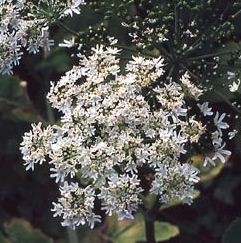Hogweed
(Heracleum sphondylium elegans)

Description
Heracleum sphondylium, commonly known as hogweed, common hogweed or cow parsnip, is a herbaceous perennial or biennial plant, in the umbelliferous family Apiaceae that includes fennel, cow parsley, ground elder and giant hogweed. It is native to Europe and Asia. The common name eltrot may also be applied, but is not specific to this species. Umbelliferous plants are so named because of the umbrella-like arrangement of flowers they produce. The North American species Heracleum maximum (also called cow parsnip) is sometimes included as a subspecies of H. sphondylium. The plant provides a great deal of nectar for pollinators. It was rated in the top 10 for most nectar production (nectar per unit cover per year) in a UK plants survey conducted by the AgriLand project which is supported by the UK Insect Pollinators Initiative. Heracleum sphondylium reaches on average 50–120 centimetres (20–47 in) of height, with a maximum of 2 metres (6 ft 7 in). The hollow, ridged stem with bristly hairs arises from a large tap root. The leaves can reach 50 centimetres (20 in) of length. They are once or twice pinnate, hairy and serrated, divided into 3–5 lobed segments. Hogweed has 5-petalled pinkish or white flowers, arranged in umbels usually less than 30 cm of diameter with 15 to 30 rays. The peripheral flowers have a radial symmetry (zygomorphic). The terminal umbels are flat-topped and the outermost petals are enlarged. Flowering typically occurs between June and October. The flowers are pollinated by insects, such as beetles, wasps and especially flies. The small fruits are schizocarps, flattened and winged, elliptical to rounded and glabrous, up to 1 cm long. The seed dispersal is by wind (anemochory). The characteristic pig-like smell of the flowers gives it its name. The leaves are commonly mined by the larvae of the leaf miner Phytomyza spondylii. Heracleum sphondylium is smaller than dangerous Heracleum mantegazzianum (giant hogweed) and Heracleum sosnowskyi (Sosnowsky's hogweed), and should not be confused. However, it contains some of the same phytophototoxic compounds (furanocoumarins), albeit at lower concentrations, and there is evidence that the sap from common hogweed can also produce phytophotodermatitis (burns and rashes) when contaminated skin is exposed to sunlight.Care therefore needs to be used when cutting or trimming it, to prevent 'strimmers rash'. The small picture-winged fly Euleia heraclei is, as its name suggests, found on hogweed.
Taxonomic tree:







